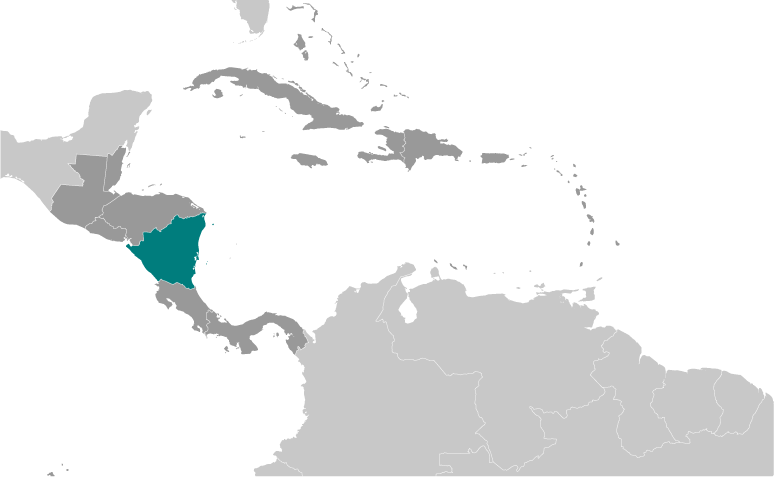
|
|
Advertisements:
People And SocietyNationality
Noun Nicaraguan(s)
Adjective Nicaraguan Ethnic groups
Mestizo (mixed Amerindian and white) 69%, white 17%, black 9%, Amerindian 5% Languages
Spanish (official) 97.5%, Miskito 1.7%, other 0.8% (1995 census) Note English and indigenous languages found on the Atlantic coast Religions
Roman Catholic 58.5%, Protestant 23.2% (Evangelical 21.6%, Moravian 1.6%), Jehovah's Witnesses 0.9%, other 1.7%, none 15.7% (2005 census) Population World Ranking: 108
5,727,707 (July 2012 est.)
Age structure
0-14 years
31.7% (male 913,905/female 879,818) 15-64 years 63.8% (male 1,743,591/female 1,874,025) 65 years and over 4.5% (male 116,153/female 138,809) (2011 est.) Median age
Total 23.4 years
Male 22.6 years Female 24.2 years (2012 est.) Population growth rate World Ranking: 111
1.067% (2012 est.)
Birth rate World Ranking: 97
19.12 births/1,000 population (2012 est.) Death rate World Ranking: 183
5.04 deaths/1,000 population (July 2012 est.) Net migration rate World Ranking: 181
-3.4 migrant(s)/1,000 population (2012 est.) Urbanization
Urban population 57% of total population (2010)
Rate of urbanization 2% annual rate of change (2010-15 est.) Major cities - population
MANAGUA (capital) 934,000 (2009) Sex ratio
At birth 1.05 male(s)/female
Under 15 years 1.04 male(s)/female 15-64 years 0.93 male(s)/female 65 years and over 0.83 male(s)/female Total population 0.96 male(s)/female (2011 est.) Maternal mortality rate World Ranking: 76
95 deaths/100,000 live births (2010) Infant mortality rate World Ranking: 88
Total 21.86 deaths/1,000 live births
Male 25.05 deaths/1,000 live births Female 18.5 deaths/1,000 live births (2012 est.) Life expectancy at birth World Ranking: 129
Total population 72.18 years
Male 70.07 years Female 74.39 years (2012 est.) Total fertility rate World Ranking: 118
2.08 children born/woman (2012 est.) Health expenditures World Ranking: 38
9.5% of GDP (2009)
Physicians density
0.37 physicians/1,000 population (2003) Hospital bed density
0.9 beds/1,000 population (2008) Hiv/aids - adult prevalence rate World Ranking: 106
0.2% (2009 est.)
Hiv/aids - people living with hiv/aids World Ranking: 112
6,900 (2009 est.)
Hiv/aids - deaths World Ranking: 94
Fewer than 500 (2009 est.)
Major infectious diseases
Degree of risk High
Food or waterborne diseases Bacterial diarrhea, hepatitis A, and typhoid fever Vectorborne disease Dengue fever and malariaWater contact disease Leptospirosis (2009) Children under the age of 5 years underweight World Ranking: 89
4.3% (2004)
Education expenditures World Ranking: 130
3.1% of GDP (2003)
Literacy
Definition
Age 15 and over can read and write Total population 67.5%Male 67.2% Female 67.8% (2003 est.) School life expectancy (primary to tertiary education)
Total 11 years
Male 11 years Female 11 years (2003) Unemployment, youth ages 15-24 World Ranking: 112
Total 8.6%
Male 8.1% Female 9.7% (2006)
Comments
Add a new comment: |
Advertisement
Members area
Nicaragua (Managua):
 
GPS points from Nicaragua (Managua)
|
||||||||

 The Pacific coast of Nicaragua was settled as a Spanish colony from Panama in the early 16th century. Independence from Spain was declared in 1821 and the country became an independent republic in 1838. Britain occupied the Caribbean Coast in the first half of the 19th century, but gradually ceded control of the region in subsequent decades. Violent opposition to governmental manipulation and corruption spread to all classes by 1978 and resulted in a short-lived civil war that brought the Marxist Sandinista guerrillas to power in 1979. Nicaraguan aid to leftist rebels in El Salvador caused the US to sponsor anti-Sandinista contra guerrillas through much of the 1980s. After losing free and fair elections in 1990, 1996, and 2001, former Sandinista President Daniel ORTEGA Saavedra was elected president in 2006 and reelected in 2011. The 2008 municipal elections, 2010 regional elections, and November 2011 presidential elections were marred by widespread irregularities. Nicaragua's infrastructure and economy - hard hit by the earlier civil war and by Hurricane Mitch in 1998 - are slowly being rebuilt, but democratic institutions have been weakened under the ORTEGA administration.
The Pacific coast of Nicaragua was settled as a Spanish colony from Panama in the early 16th century. Independence from Spain was declared in 1821 and the country became an independent republic in 1838. Britain occupied the Caribbean Coast in the first half of the 19th century, but gradually ceded control of the region in subsequent decades. Violent opposition to governmental manipulation and corruption spread to all classes by 1978 and resulted in a short-lived civil war that brought the Marxist Sandinista guerrillas to power in 1979. Nicaraguan aid to leftist rebels in El Salvador caused the US to sponsor anti-Sandinista contra guerrillas through much of the 1980s. After losing free and fair elections in 1990, 1996, and 2001, former Sandinista President Daniel ORTEGA Saavedra was elected president in 2006 and reelected in 2011. The 2008 municipal elections, 2010 regional elections, and November 2011 presidential elections were marred by widespread irregularities. Nicaragua's infrastructure and economy - hard hit by the earlier civil war and by Hurricane Mitch in 1998 - are slowly being rebuilt, but democratic institutions have been weakened under the ORTEGA administration.